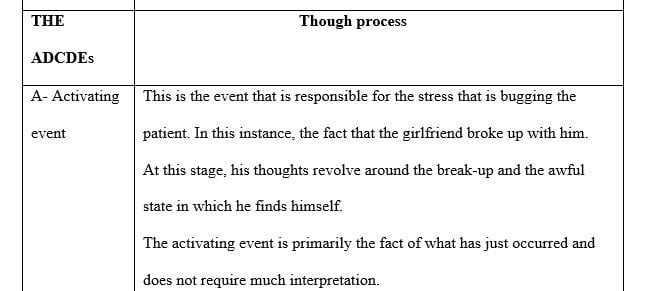Imagine that you are beginning treatment with two new clients with the following issues
The Activating Event, Belief, Consequence, Disputation, and Emotion (ABCDE) of Rational Emotive Behavior Therapy
Note: This week, you complete and submit your Assignment before beginning the Discussion.
Imagine that a client says during a session, “I don’t think my dad loves me. He certainly never has never shown it. When I was growing up, he worked all the time.” A possible reaction to this statement might be as simple as: “Prove it. What evidence do you have that he doesn’t love you?” The client might be able to provide some evidence, but likely if the father was working too much, he might have been expressing that love through providing financial support. A practitioner of REBT might go even further to suggest what Ellis terms an elegant solution: what matters isn’t whether your dad loves you—maybe he does, maybe he does not—your irrational thought is that you need to be loved by your dad (you want to be loved by him, but you do not need his love).
The REBT approach to helping a client understand her/his problem is to teach them the ABCDE framework. This technique can be completed with clients or assigned as homework. Consider the following simple example of how ABCDE can be used to help identify irrational thoughts:
Activating event is the event or behavior that causes stress or negative reactions. I hate it when people chew out loud, and especially if they also have their mouths open.
Belief is a person’s feelings, interpretations, and self-talk about the event. How brutish and completely disgusting! Am I chewing like that? Can other people hear me chewing? I can’t believe I have to sit next to this person masticating her food like an animal. Make it stop!!!
Consequences are the actual emotions that a person feels, which may vary in degree from strongly to weakly felt. Anger, revulsion, annoyance, disgust.
Disputation is a counter thought or alternative way of thinking about the situation. Working through this step may involve questioning, reframing, Socratic questioning, humor, rational emotive imagery, or talking the situation through with others. This guides the person to see that his or her belief about an act is the cause of the disturbance and not the act itself. Where is it written that a person shouldn’t chew out loud? I prefer the person not chew so loudly, but her actions are not a reflection of my behavior or character.
Emotional Effect represents the more positive beliefs or behaviors that a person is able to have after disputing the irrational belief(s). When a client is able to surrender the irrational belief, he or she will be able to revise or replace them with new emotions. Everyone is different and chewing styles can vary for many reasons, including culture, hunger, and enjoyment of the food. I don’t need to worry about how others chew.
For this Assignment, you view mock sessions and complete an ABCDE analysis of each session. As you watch the sessions, look for the activating event(s) and consider what the clients in each session were thinking and saying to themselves.
To prepare:
Review Dobson Chapter 8, specifically p. 253, and the Ellis article, REBT Self Help Form found in this week’s Learning Resources.
Imagine that you are beginning treatment with two new clients with the following issues:
35-year-old female suffering from depression who lost a job recently due to poor performance
22-year-old male whose girlfriend broke up with him
After considering these very brief client scenarios, complete the ABCDE’s of REBT Template for each one. You will need to interpret what you think the client’s beliefs may be, based on the limited information you have.
For this Assignment:
Complete the ABCDE’s of REBT Template for each mock client scenario.
Submit your ABCDE’s of REBT Assignment Templates for each client scenario by Day 3.
READINGS
Dryden, W., David, D., & Ellis, A. (2010). Rational emotive behavior therapy. In K. S. Dobson (Ed.), Handbook of cognitive behavioral therapies (3rd ed.) (pp. 226–276). New York, NY: Guilford Press.
Ellis, A. (1989). Using rational-emotive therapy (RET) as a crisis intervention: A single session with a suicidal client. Individual Psychology: Journal of Adlerian Theory, Research & Practice, 45(1/2), 75–81. Retrieved from the EBSCO databases (Accession No. 9102702).
Using Rational-Emotive Therapy (RET) as Crisis Intervention: A Single Session with a Suicidal Client by Ellis, A., in Individual Psychology, Vol. 45/Issue 1-2. Copyright 1989 by University of Texas Press – Journals. Reprinted by permission of University of Texas Press – Journals via the Copyright Clearance Center.
Note: You will access this article from the Walden Library databases.
Ellis, A. (2000). REBT self-help form. Retrieved from http://www.hypnosisrebt.com/pdf_files/III-13.pdf
Shea, D. (2016). Basic tenets of REBT/CBT. Cognitive behavioral approaches for counselors (pp. 21–38). Thousand Oaks, CA: Sage Publications.
Cognitive Behavioral Approaches for Counselors, 1st Edition by Shea, D. Copyright 2016 by Sage College. Reprinted by permission of Sage College via the Copyright Clearance Center.
Answer preview to imagine that you are beginning treatment with two new clients with the following issues
APA
574 words


